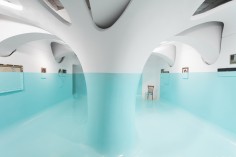Davide D’Elia
Antivegetativa
source: lanciatrendvisions
Dopo gli esordi nella pittura informale, dalla seconda metà degli anni 2000 l’artista Davide D’Elia (’73) sperimenta fenomeni legati alla natura, come l’interazione fra agenti atmosferici e manufatti. La mostra “Antivegetativa”, alla Ex Elettrofonica di Roma, prosegue nel percorso.
Con questo progetto, l’artista di Salerno riprende il discorso aperto nel 2010 alla galleria capitolina con la prima mostra intitolata “Ieri distrattamente mi volsi a considerar altrui memorie (dalle quali mi ritrovai rinvigorito)”.
La mostra presentava un sistema in grado di far nascere muffe su alcuni spazi prestabiliti della galleria, mostrando ciò che è “invisibile”, ovvero la presenza costante della vita e lo scorrere del tempo.
Con “Antivegetativa”, il processo è contrario: D’Elia applica su metà degli spazi della galleria un antivegetativo, vernice usata soprattutto in campo nautico per arrestare la crescita di alghe, coralli e muffe sulle carene delle imbarcazioni.
Il colore verde asettico della vernice assale ogni cosa, quadri, sculture, elementi d’arredo, come a congelare qualsiasi proliferazione di vita. Un’opposizione tra organico e sintetico, tra vitale e asettico, caldo e freddo, formale e informale che racconta anche il mondo di oggi.
.
.
.
.
.
.
.
source: davidedelia
Davide D’Elia produces work that often re-values modern aesthetic graphic terminology by presenting itself beyond object and objectivity (which are nevertheless important symbols), by which he obtains a reasoning that examines the concepts of time and the flow of time. By working on the residue of what remains and the aesthetics of this transformation, he forces us to consider the possibilities of time that passes and time that has passed. Born in Cava de ‘Tirreni (SA) in 1973, graduated in graphic design at l’Istituto Superiore di Design di Napoli in 1996. He currently lives and works between Rome and London. David D’Elia draws from the vocabulary of the neglected and the degraded: the humidity created by the water dripping from the tap, moisture stains on the canvas or the marks left on the wallpaper by dismissed frames.The artist observes and lets them start growing spontaneously: passing the time, their increasing shapes become drawings made by the nature on the object of art. If the laboratory represents for the artist an unlimited source of experimental methods of creation, the scientific curiosity is just a starting point for his desire of identification with other forms of life…
.
.
.
.
.
.
.
source: curamagazine
Initially close to informal painting and later to graphic art, from the second half of the last decade Davide D’Elia’s work has been characterized by the interaction between physical agents and artistic handiwork, the results of which the artist has explored through an intimate and ever-renewed dialogue between time and material. Antivegetativa (antivegetative, the name in Italian of anti-fouling paint) is composed of paint, a chair, a buoy and nineteen paintings from old cellars, flea markets, antique shops and junkyards of Rome. The canvases show seascapes, rocky landscapes, photo portraits touched up by hand and images of “youngsters” from an age now forgotten by history. The chair on the other hand is the conceptual site where time stops, while the buoy is the emblem of the spatial limit not to be passed. The paintings, academic in style, the chair and the buoy have all been half-immersed in the thick “Tiffany blue” paint – so-called because it came into being the same year as the famous brand – with which the artist has permeated the Ex Elettrofonica space. Anti-fouling paint of the thick variety is normally applied as a coating for the hulls of old ships and is particular in that it seals out plant and animal organisms to the point of eliminating every possible form of life. The result is an acidic and unreal space, immersed in the abysses of the a material that erases everything, including space, time and life. From the process of immersion of the objects in the paint stems a reflection on a stretch of common history, that of things, and this gives rise to another, much deeper one, on what remains beyond the end of material. Through the process of cancellation of natural processes, Antivegetativa is an experiment in halting nature’s physicality, as well as the passing of time.


